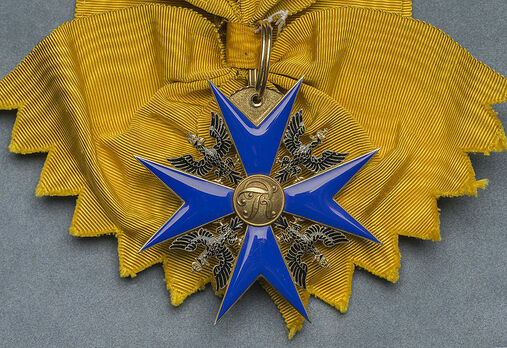High Order of the Black Eagle, Cross (in gold, early version)
CATEGORY: Version
SKU: 01.PRU.0101.102.01.000
Estimated market value:

Estimated market value:
42 grams.
The High Order of the Black Eagle was founded by Elector Friedrich III of Brandenburg on the day before his coronation to become King Friedrich I of Prussia. Elector Friedrich III instituted the Order to demonstrate the importance and dignity of Prussia within the European hierarchy.
The order was primarily conferred upon foreign and domestic princes, heads of state, and dignitaries in recognition of extraordinary civil and military merit and achievements. It was also awarded to members of the Prussian military.
The black eagle was chosen to symbolize justice, and to represent the coat of arms of the state. The eagle clutches a laurel wreath in one claw, as the reward of justice, and a lightning bolt, the punishment of justice, in the other claw.
The statutes for the order were largely based on the Danish Order of the Elephant, British Order of the Garter, and Spanish Order of the Golden Fleece. In line with these other European orders, the number of Knights was set at 30, not including the royal princes who were awarded the order at the time of their birth. For non-royal Knights, the minimum age was set at 30. However, the membership limit was not observed between 1713 to 1847, when the 30 member limit only applied to residents.
From 1703 to 1847, the order was only awarded to members of nobility who could trace their lineage through multiple generations.
The order featured only one grade, which included a Collar, Cross, and an associated Breast Star. The reigning king could award the order with or without the collar. The order members had to wear their decorations at all times or risk fines for violating the order’s rules. Knights of foreign states were allowed to wear the cross on a neck ribbon or a ribbon bow on the chest.
The first 19 awards of the order took place on January 17, 1701. The recipients swore by the statutes and received the decoration on the shoulder ribbon at the appointment, and at the investiture would receive the chain from the king. In May 1742, Marie August, widowed Duchess of Württemberg, was the first woman to be awarded the order.
In 1809, King Friedrich Wilhelm III considered expanding the order into four classes, with a decoration with a wreath for sub-officials, etc. However, this plan was transferred to the Red Eagle Order in January 1810.
On February 20, 1847, King Friedrich Wilhelm IV amended the order to include individuals who were not of noble lineage. These recipients, in turn, would receive hereditary nobility.
The order decorations could be conferred with diamonds to members of royal families and other high-ranking recipients for exceptional merit. In 1743, Elisabeth Petronova, Empress of Russia was awarded the order with diamonds, with a value of 40,000 thalers. In 1762, Catherine II, Empress of Russia received the order with pearls, with a value of 30,000 thalers.
The order's motto was "Suum Cuique", which translates to “To each according to their merits”.
The order was discontinued in 1918.
The Cross of the order was composed of three parts. A total of 1,341 were awarded, 1,129 of which between 1700 and 1900, 85 between 1900 and 1908, 114 between 1908 and 1918, and 19 between 1919 and 1934. The first awards were supplied by Wilhelm Eissenhardt in Berlin.
The Cross with Diamonds, which surround the centre medallion, was awarded a total of 92 times, 71 of which between 1742 and 1900, 20 between 1908 and 1914, and one in 1932. The first award took place in November of 1742, to Imperial Russian Lieutenant General Mikahil Larionovich Count Vorontsov.
Only one example has survived from the first creation of the Cross in 1701, when 19 decorations were made. The eagles in the quadrants between the arms are small, and the arms are painted black.
In examples between 1785 and 1795, the arms were less curved and the eagles are half size. Later decorations have larger eagles.
A Cross for non-Christians was instituted in 1857, which avoids the shape of the cross. It was awarded five times in total, four of which were awarded to Persian individuals and one to a Chinese Emperor. All but one (to Nasir od-Din, Shah of Persia) were awarded with diamonds.

Comments
Sign in to comment and reply.


Scroll Top